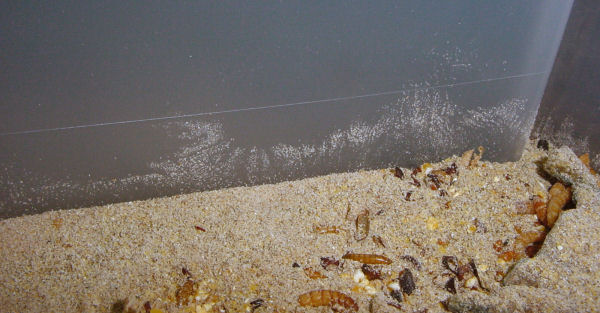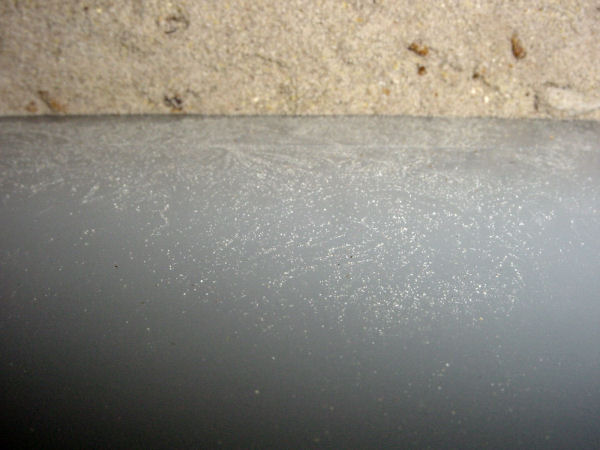» Bifurcated
» Meal Worm MitesMeal Worm Mites
This winter I have been noticing something odd in my meal worm farm. It appeared as if frass or grain dust was slowly climbing the walls of the container over the course of a day. When I open the container or touch the side of it, the flakes would slowly descend or just fall. I attributed this to static electricity generated by all of the worms constantly moving and my activity would remove the charge and make the particles fall. Well, I eventually found a lot of these particles bunched up outside of the drawer and I spent some time analyzing this thing and it turns out they they are all alive. I have a major microscopic mite infestation.
These images are a day or two after I cleaned and are a very light version of what I originally found.
 | Meal worm mites |
 | Meal worm mites |
The mites may bunch up around fresh air holes or orifices and they look like a very fine sawdust or simply house dust. The mites are tiny and round, whitish or tan in color, and have eight legs and cannot fly. The mites may come from the mealworm supplier, in the bran or litter, and may infest a colony that has been around for a long period of time. Excessive moisture + heat may be a contributor. They are prolific breeders (800 eggs/female) and can withstand temperatures of 0 degrees and still hatch when brought to room temperature. (Another species that can be a problem is the mold mite, Tyrophagus sp.)
A home based meal worm farm could be infested by any number of mites including: grain, dust, mould, cheese, flour, acari, and countless others.
If your colony does become infested, the mites will kill the larvae and adults. You have to destroy the colony (e.g. by freezing) and start over.
To prevent mite infestation:
- Jack Finch recommended sterilizing all bran/grain (by microwaving it or placing it in a subzero freezer for several days) prior to adding it to a colony to prevent mite introduction.
- Use only wheat middlings/hulls.
- Create a moat. Place mealworm containers up on legs, and sit the legs inside small glass or plastic jars filled with water or glycerine (which won't evapoarte like soapy water does). This will also keep ants out.
- use a vaseline band (a 2" wide band on the outside of the container just after you wash and dry it) to prevent mites from getting into a worm bed.
- Blaine Johnson thought using apples and potatoes as a moisture source may have connected to a mite problem he had, and switched to carrots.
- Store grain that will be used in the future inside tightly sealed containers.
- Kees Van Epenhuijsen (an entomologist from New Zealand) said they achieved 100% mite mortality by using an acaricide paint (Artilin.) Place mealworm containers on top of a piece of plywood painted with the acaricide. This product is NOT available in the United States. Products used to protect beehives from mites (stinky strips put at the entrance to hives) and fumigants (which contain thymol, methol and eucalytus oil) are too volatile to be used indoors and have no residual action. (I wonder if eucalytus leaves would work?)
Tyrophagus - grain or mold mites, are closely related to dust mites




A mold mite (related to dust mites), Tyrophagus putrescentiae, magnified about 100x. USDA/ARS; Photo by Eric Erbe; digital colorization by Chris Pooley.
[1]
SEE ALSO:
Meal worm mites be gone
|






